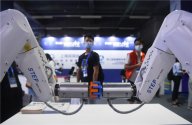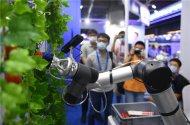You are using an out of date browser. It may not display this or other websites correctly.
You should upgrade or use an alternative browser.
You should upgrade or use an alternative browser.
News on China's scientific and technological development.
- Thread starter Quickie
- Start date
supercat
Colonel
New studies suggest that China is getting ahead both in quantum communication and quantum computing:
China Is Pulling Ahead in Global Quantum Race, New Studies Suggest
The competition between the U.S. and China over development of quantum technology has implications for both the future of science and the two countries’ political relations
When a team of Chinese scientists beamed entangled photons from the nation’s Micius satellite to conduct the world’s first quantum-secured video call in 2017, experts declared that China had taken the lead in quantum communications. New research suggests that lead has extended to quantum computing as well.
In three preprint papers posted on arXiv.org last month, physicists at the University of Science and Technology of China (USTC) reported critical advances in both quantum communication and quantum computing. In one of the studies, researchers used nanometer-scale semiconductors called quantum dots to reliably transmit single photons—an essential resource for any quantum network—over 300 kilometers of fiber, well over 100 times farther than previous attempts. In another, scientists improved their photonic quantum computer from 76 detected photons to 113, a dramatic upgrade to its “quantum advantage,” or how much faster it is than classical computers at one specific task. The third paper introduced Zuchongzhi, made of 66 superconducting qubits, and performed a problem with 56 of them—a figure similar to the 53 qubits used in Google’s quantum computer Sycamore, which set a .
“It’s an exciting development. I did not know that they were coming out with not one but two of these [quantum computing results] in the same week,” says Scott Aaronson, a theoretical computer scientist at the University of Texas at Austin. “That's pretty insane.”
All three achievements are world-leading, but Zuchongzhi in particular has scientists talking because it is the first corroboration of Google’s landmark 2019 result. “I’m very pleased that someone has reproduced the experiment and shown that it works properly,” says John Martinis, a former Google researcher who led the effort to build Sycamore. “That’s really good for the field, that superconducting qubits are a stable platform where you can really build these machines.”
Seems to me that the Chinese are building a working prototype of the quantum computer based on light. The Americans are still experimenting with their superconducting materials.
It is like the Chinese here did one experiment to reproduce the results of that Google machine, then the Chinese took their same setup and tweaked it, improving reliability in this next build and adding the programming component. Since the Chinese version of the quantum computer is scalable, and with the recent results, they gonna start thinking big things.



It is like the Chinese here did one experiment to reproduce the results of that Google machine, then the Chinese took their same setup and tweaked it, improving reliability in this next build and adding the programming component. Since the Chinese version of the quantum computer is scalable, and with the recent results, they gonna start thinking big things.
This is a four-part series of conversation and interview on quantum technology, quantum supremacy, US vs China etc. They were published late last year. Interesting to read and see some of the updates and changes in the last six months or so.
Seems like they need it. It currently takes 6-7 hours to travel from Shanghai to the Greater Bay Area by regular 300kph high-speed EMUs (making required stops at junctions like Hangzhou and Changsha), and 8-9 hours from Beijing to the Greater Bay Area respectively. Business travels of more than 5 hours would be a bit too long.
More definitive developments now. In January, chief engineer Liang Jianying said the train would go into service in five to 10 years.
That China now has its own Maglev technology is a great achievement. As for the existing Shanghai Maglev, expanding and building new routes for it then was contingent on transfer of technology.
The Germans refused to sell . It has taken the Chinese a decade or more to create their own Maglev technology which is better than the German's as it can go 600+ km/h compared to the German's maximum speed of 400+ km/h. So the Germans refusal to sell this technology was ultimately futile. Otherwise, Siemens could have pocketed some more money and seen its technology in broader use. As it is now, there is only one operational example of the Siemen's Transrapid Maglev technology in real world use ie the Shanghai to Pudong airport line.
The Germans refused to sell . It has taken the Chinese a decade or more to create their own Maglev technology which is better than the German's as it can go 600+ km/h compared to the German's maximum speed of 400+ km/h. So the Germans refusal to sell this technology was ultimately futile. Otherwise, Siemens could have pocketed some more money and seen its technology in broader use. As it is now, there is only one operational example of the Siemen's Transrapid Maglev technology in real world use ie the Shanghai to Pudong airport line.




